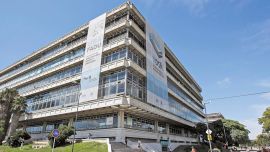There is something special about the sound of a train passing. For some of us it is the arriving or departing beep of an engine. Others choose the sound of heavy wheels on iron tracks. There is also the magnificent experience of a smooth start for such a huge beast. All these were the sounds I most enjoyed while growing up in a village, now a dormitory suburb, called Ranelagh, in Buenos Aires province. From there my father went to work “in town” and I went to school in La Plata. You could set your clocks by the time at which they stopped at the station, a neighbour once told me and repeated the assurance until her mideighties when she could say no more. The trains were British-owned up to 1949 and service was reasonable up to the mid-fifties.
Then the trains went silent, track by track. The shutdown started on branches such as the riverside Mitre line, during the government (1958-1962) of president Arturo Frondizi. And in some provinces long-distance services became erratic. Then the dismantling came to an almost absolute end during the extended rampage of president (1989- 1999) Carlos Saúl Menem. The privatisation plan by the Menem government, and the ambitions of the truckers’ trade union to expand their power and influence, was to be seen reflected in the Camioneros’ trade union and allegedly made union chief Hugo Moyano a much happier millionaire.
However, I have lain awake at night (or rushed to the front door) to hear and watch the freight trains come through Larroque from Zárate on the way to Irazusta (probably named after brothers and writers, Rodolfo, 1897-1967, and the fiery nationalist Julio, 1899-1982, both born in Gualeguaychú, Entre Ríos). The diesel engines pulling 30 to 40 cars with containers full of beans or grain or building material stopped recently, which is distressing. Irazusta was hit by heavy rain and flooding. My first train back on line was heard on Tuesday night. Glee.
The tracks here need repair or replacement. The quebracho wood sleepers with chipped or broken ends have a suspicious pre-war look, seeing as the last time the British management ordered any repairs was in 1939, before the war. The rest was all downhill. However, it is amazing that such wood sleepers should still be in normal use.
Hence the comforting feeling transmitted by an article in La Nación, by Gabriela Origlia, last Monday which reported on plans to unveil a massive programme for the refurbishment and repair of railway freight lines to bring the whole system up to date.
The news came as a kind of balm, hopefully this can happen in Argentina. The article quoted Ezequiel Lemos, director of Trenes Argentinos Cargas, stating that 45 percent of the track network was not usable when the repair plan started. The plan Lemos is announcing involves work on 9,850 kilometres of tracks mainly in Salta, Santiago del Estero, Chaco, Córdoba, Santa Fe, a bit in Entre Ríos and Buenos Aires. The modernisation so far has meant repairs over 1,300 kms of tracks, the purchase of 40 new engines, and 1,000 new freight cars. The Belgrano line, running from north to centre, has seen the highest shipment averages in 25 years, according to Lemos.
In November 2018, freight moved by rail totalled 220,561 tons more than in 1992, which is when most services rolled to a halt. More interesting are the figures for the first 11 months of last year, for which Lemos and company reported an overall volume of 1,896,591 tons of freight moved. The statement carries the hint that much more can be achieved.
Investment in the next few years will mean spending of US$8.8 billion. The big question is if that can be achieved or if it can continue under the next government we are expected to elect.
For those with a memory, it will be recalled that president (2003-2007) Néstor Kirchner announced in his inaugural speech that a revival of the railways was on his shopping list. The result was about 100km in Buenos Aires province on the San Martín line.
News reports from the mid-1940s in the run-up to a change of hands in the railways are interminable and even though train-buffs, various enthusiasts and academics have all had a shot at writing partial accounts of the Argentine system, the complexity of politics and finances have made histories near to impossible. All are generally quite partial and tendentious. There are people who say they can follow the history of railways in Argentina and their “expropriation.” But be wary, history is in a massive swamp.
In brief, British management had made it known since the mid-1930s that it wanted to sell the railways. The Times (of London), in 1938, said that Argentines would soon want their own railways. A plan for ownership changes had been in discussion in earnest roughly from the time of the Ottawa Conference in 1933, when members of the Commonwealth or Empire demanded a bigger and better share in British trade worldwide.
The “nationalisation” of 1949 in Buenos Aires was no more than a political label. President Juan Perón needed and found the right label for his government. The Uruguayans were more straightforward about the ownership transfer, calling it the “repatriation of foreign debt.” The financial settlement for the transfer of the British railways was clearly favourable to Argentina, complete with the promise of much required food exports needed by Britain in the post-war years and into the 1950s.
The post-war Labour government was in huge haste to sell the railways to Argentina by debt exchange in part to pay off United Kingdom war debts to the United States, money which in turn had been earmarked by Washington for the Marshall Plan for European recovery. Winston Churchill accused Labour of selling the trains to pay for the false teeth required under the new National Health Service in Britain.
Argentina later watched its trains travel into rapid decline. Hopefully parts of the service will now rise once again.related news





















Comments